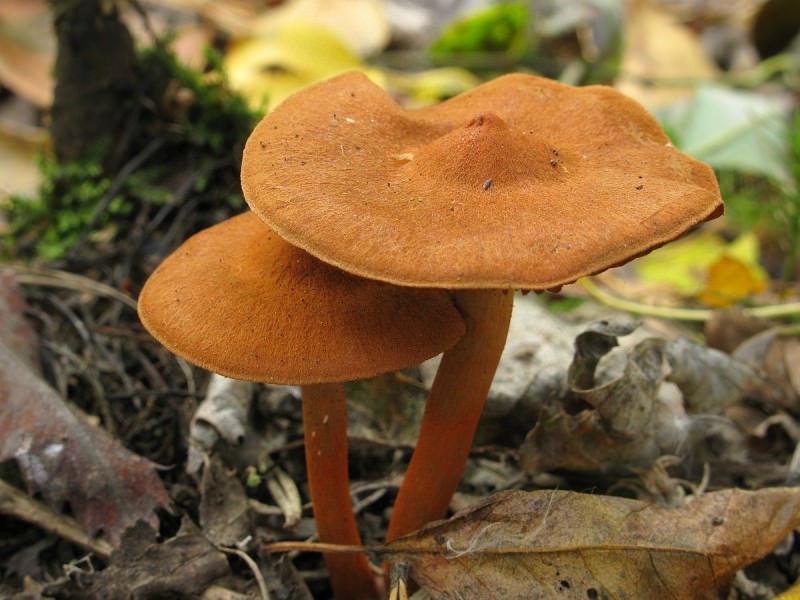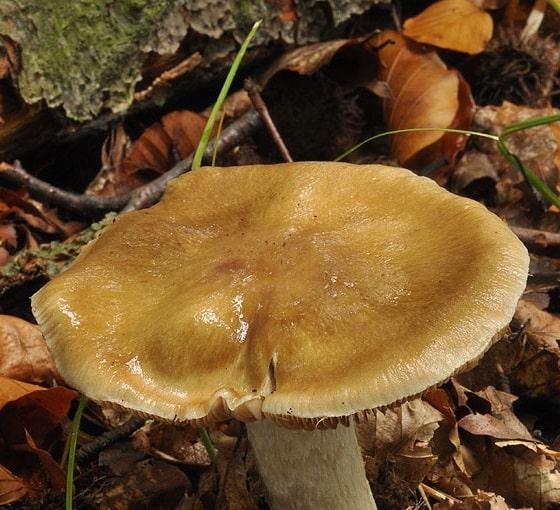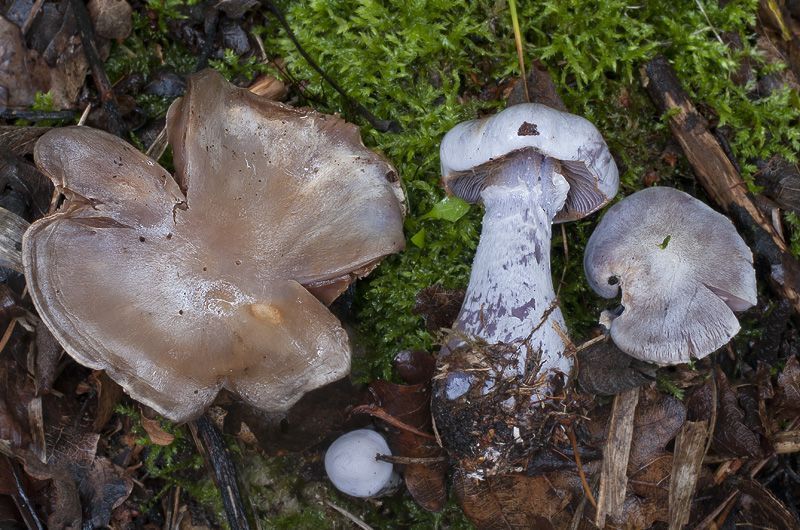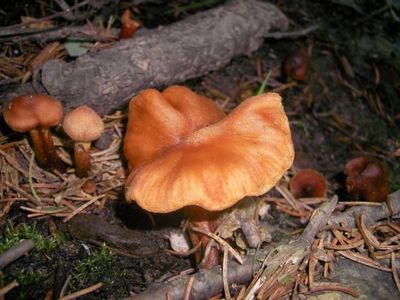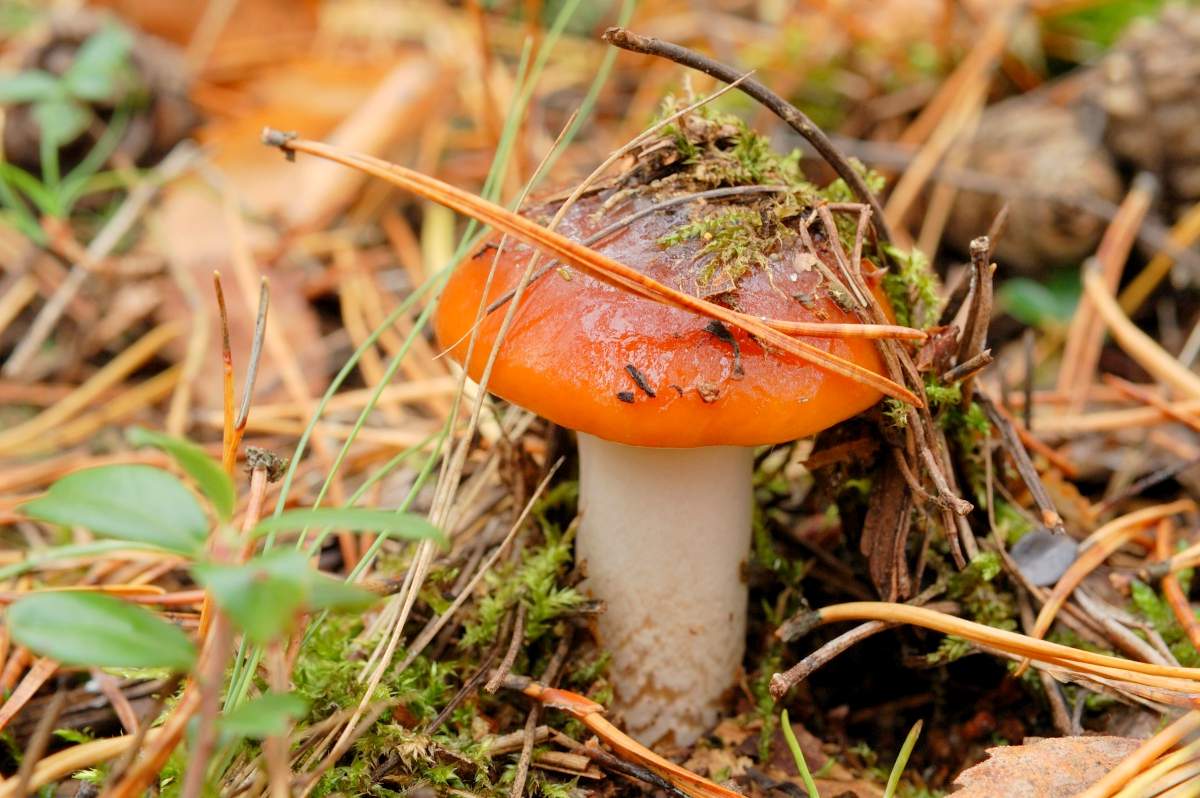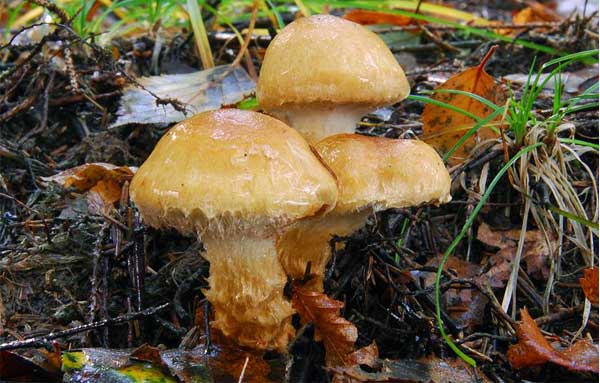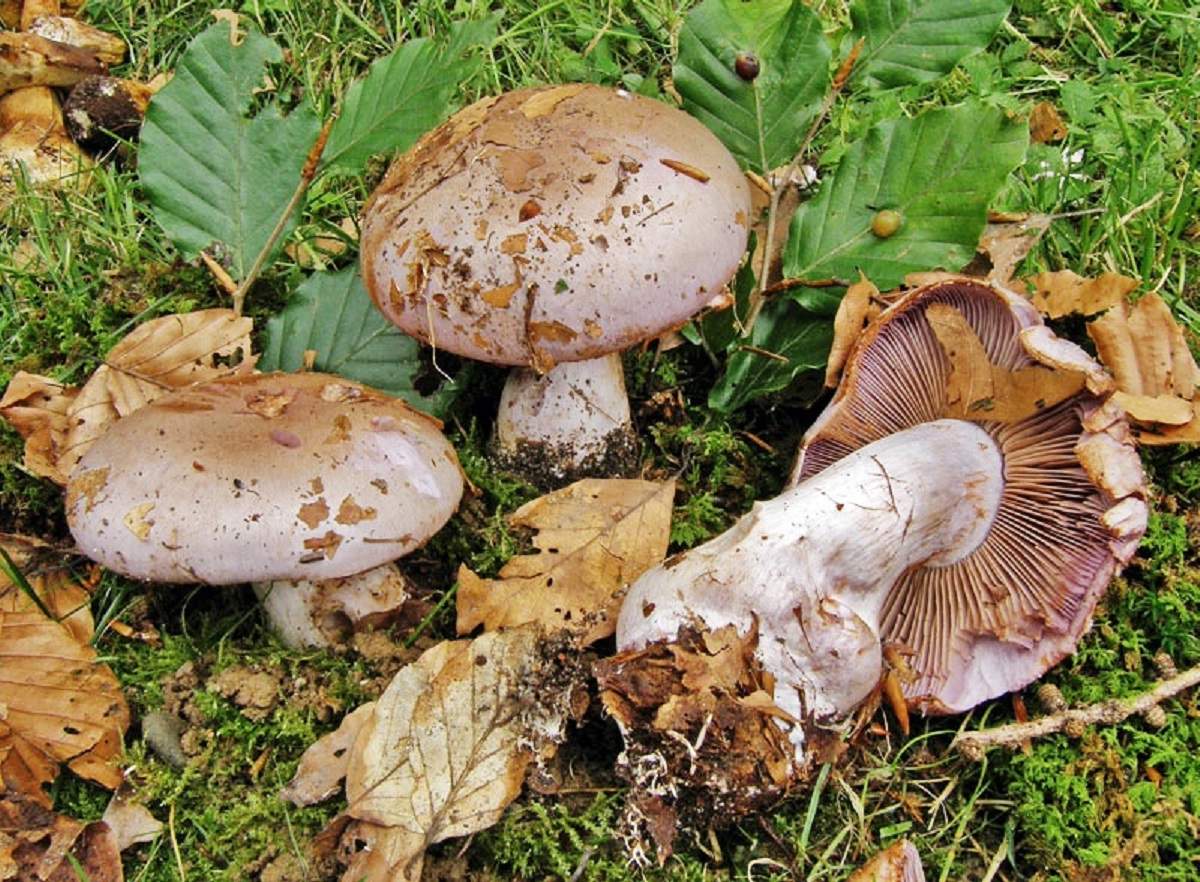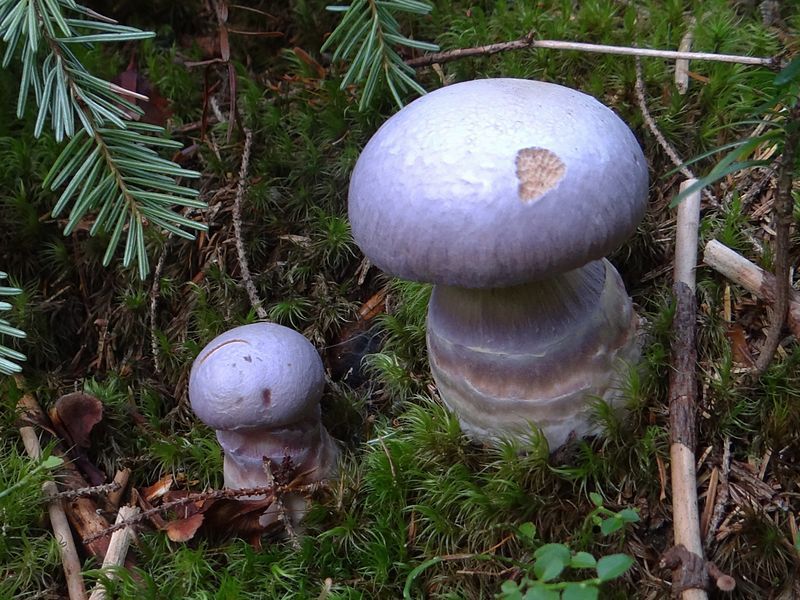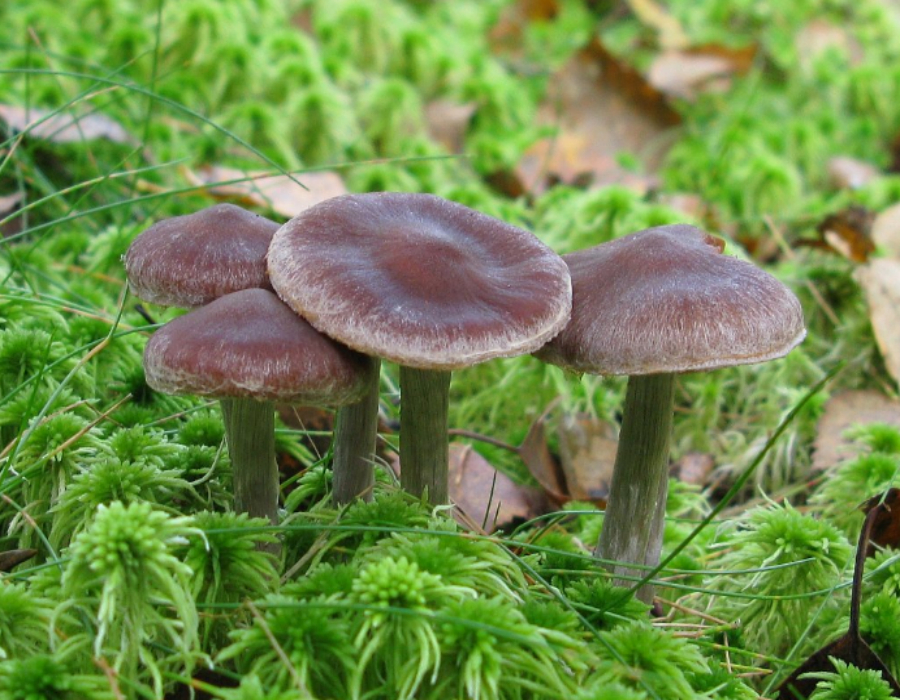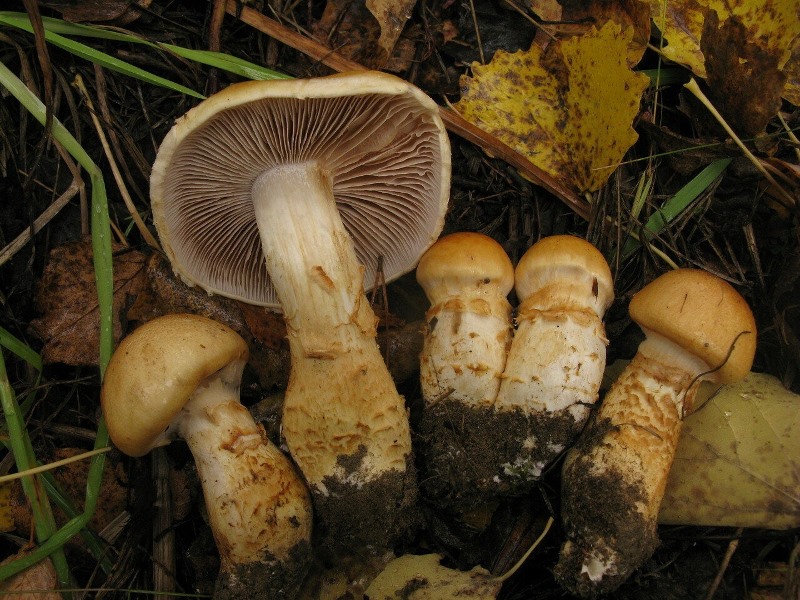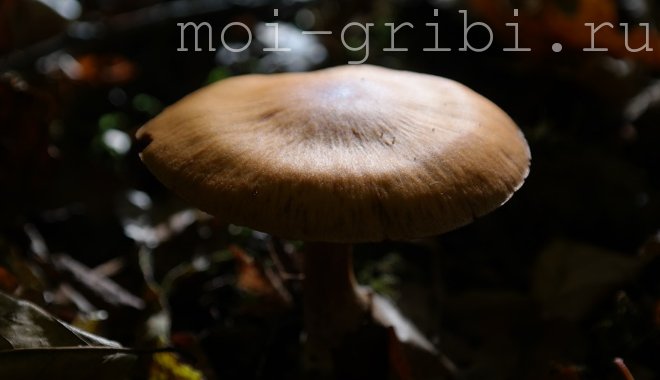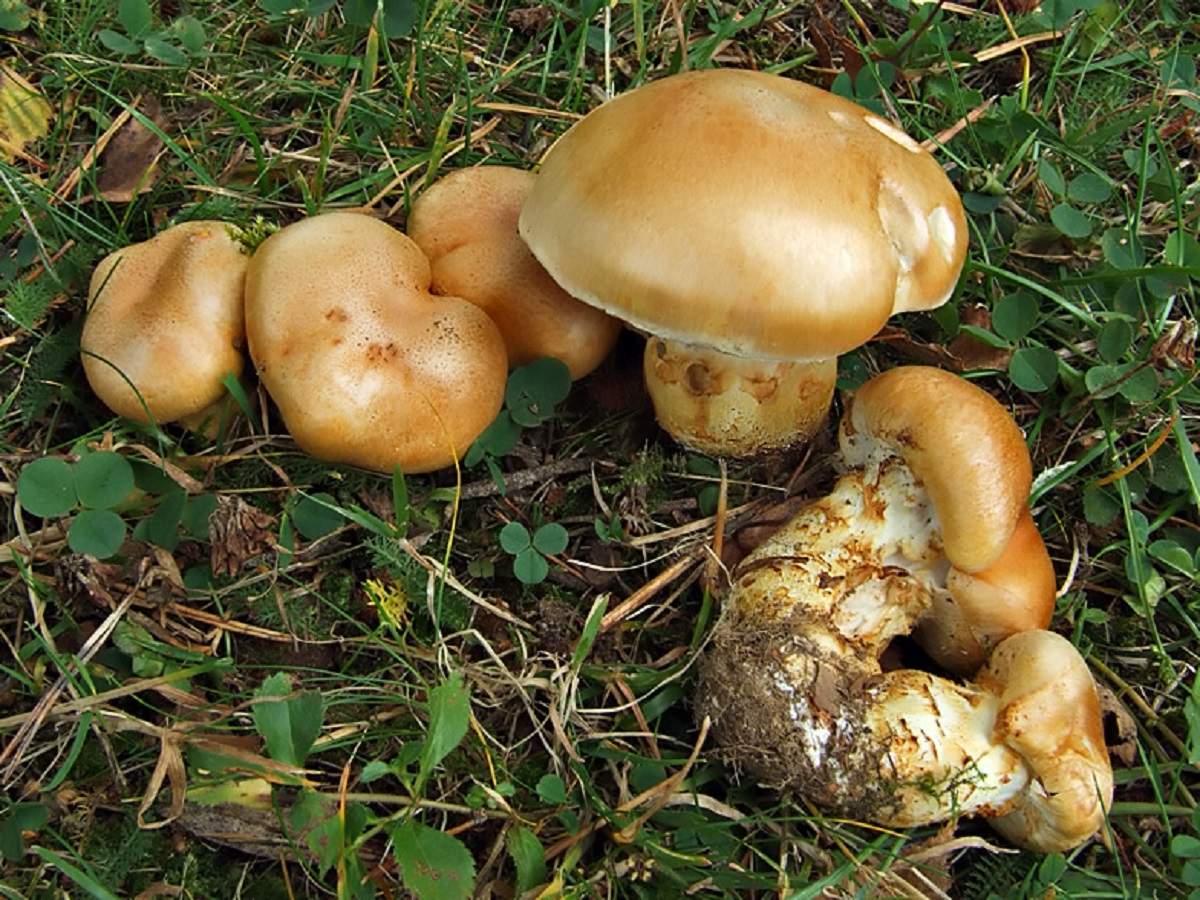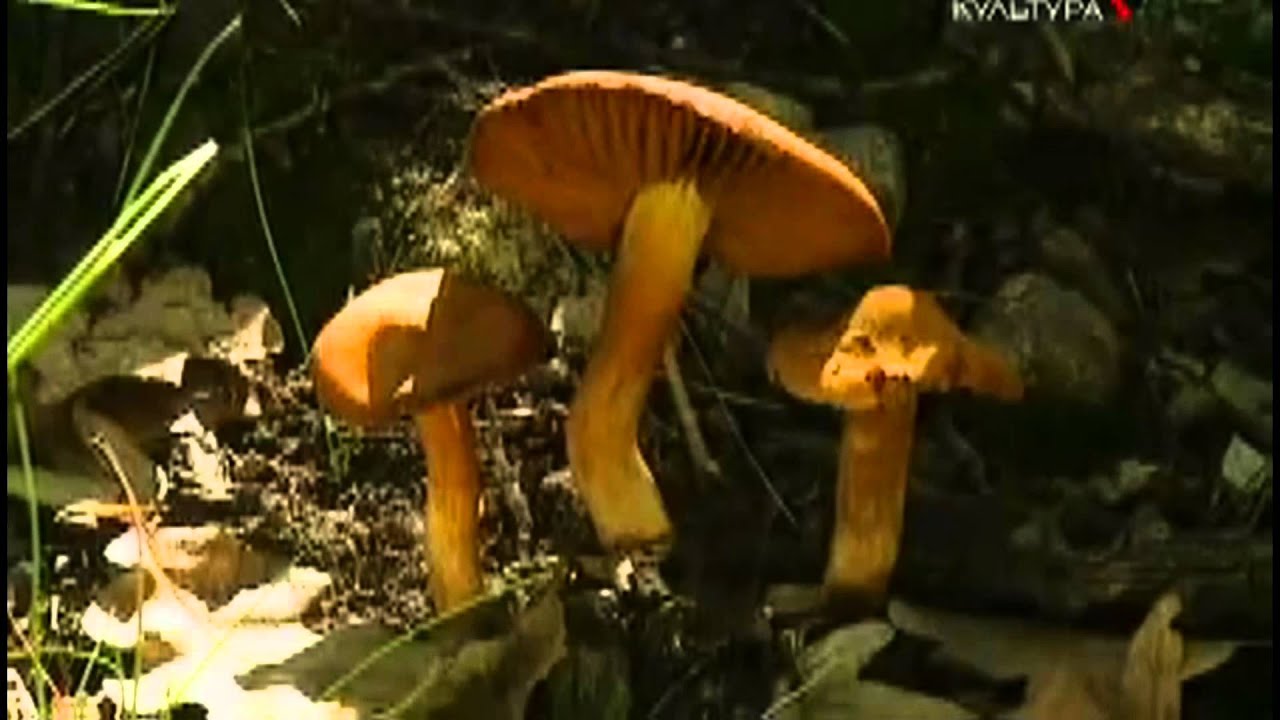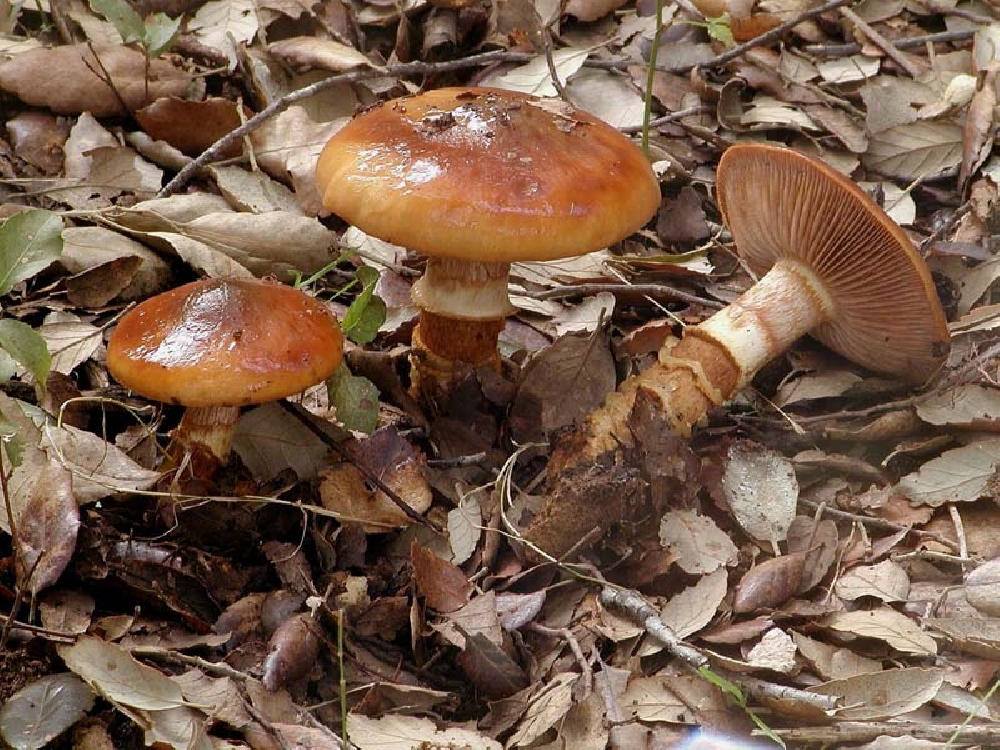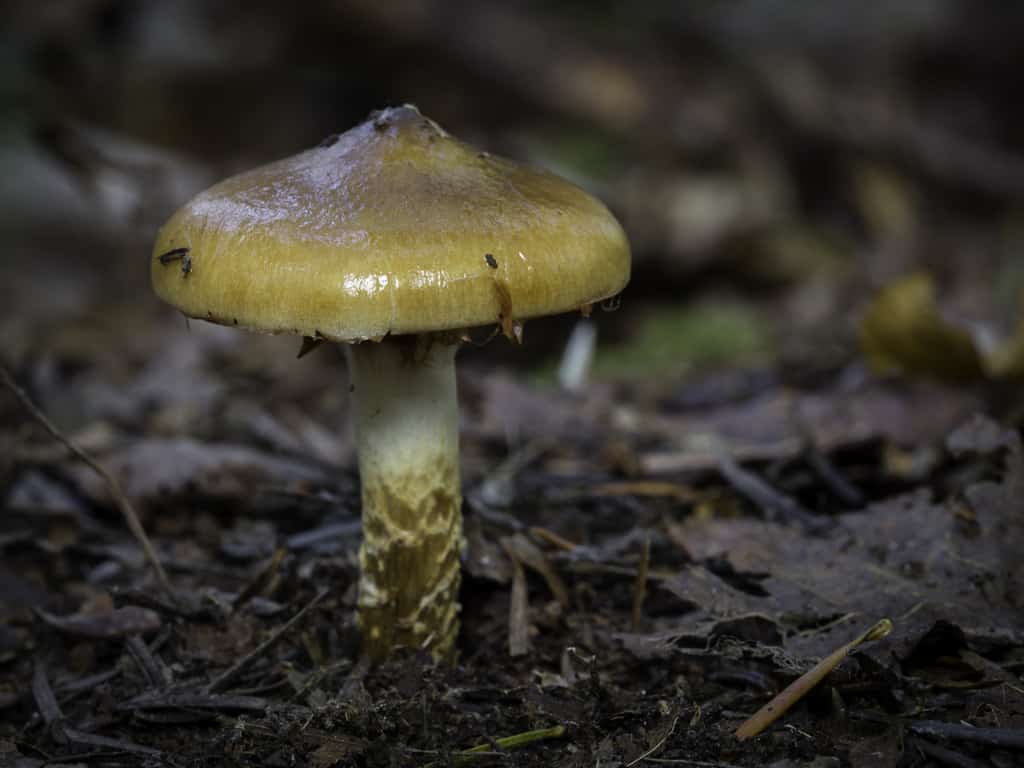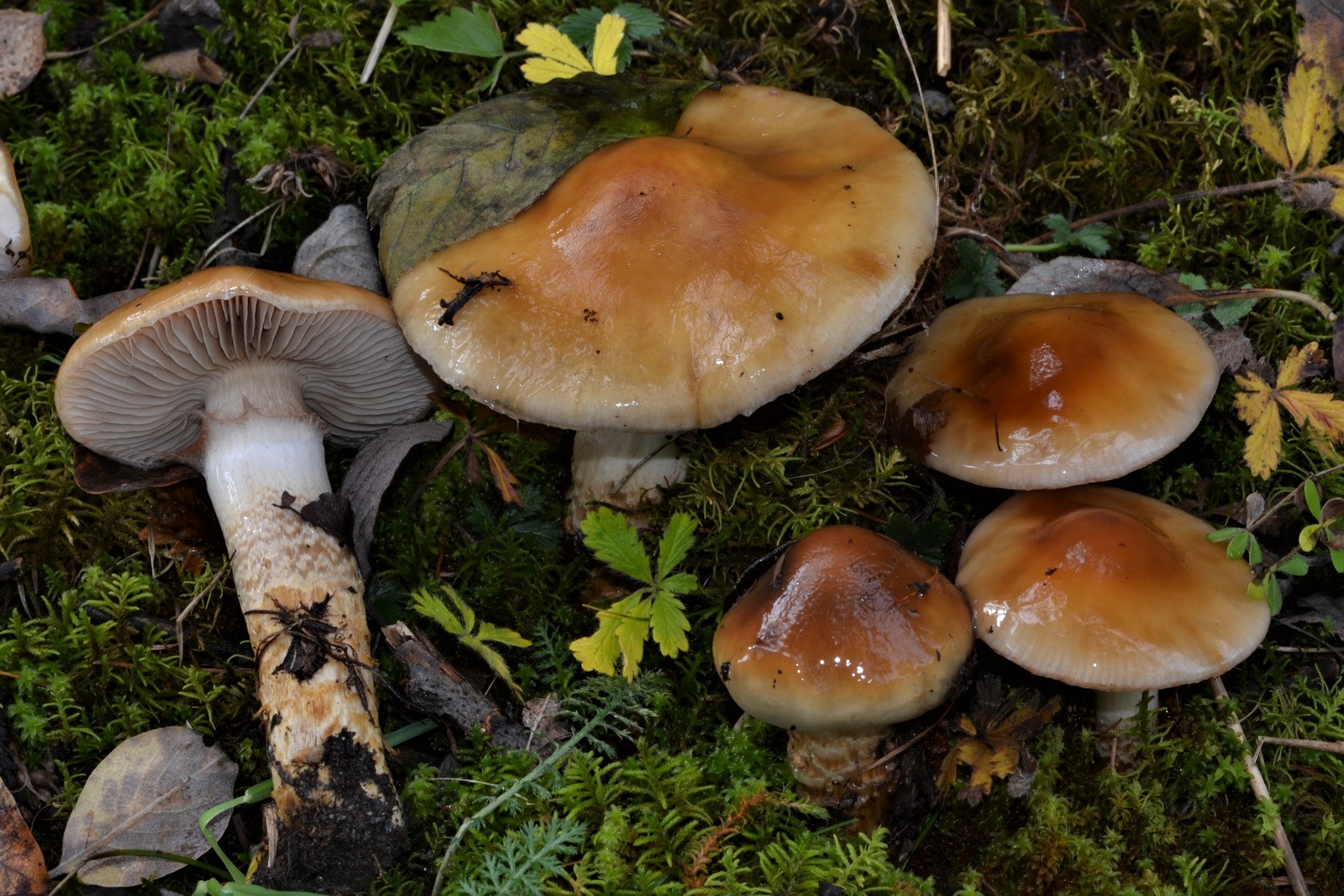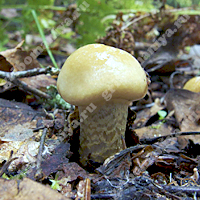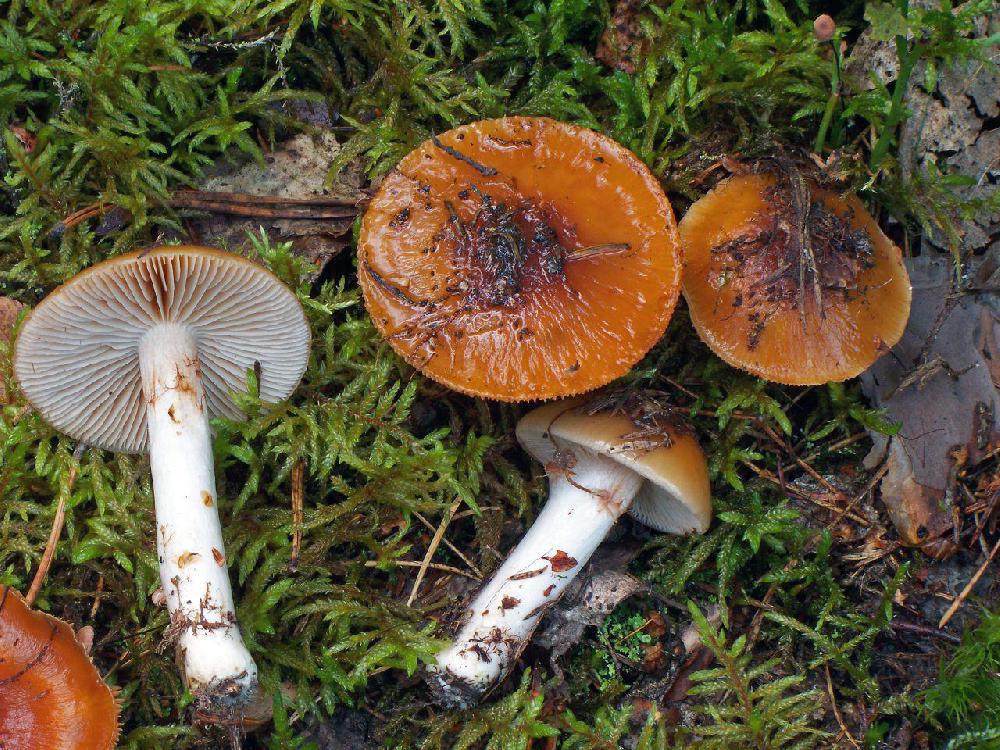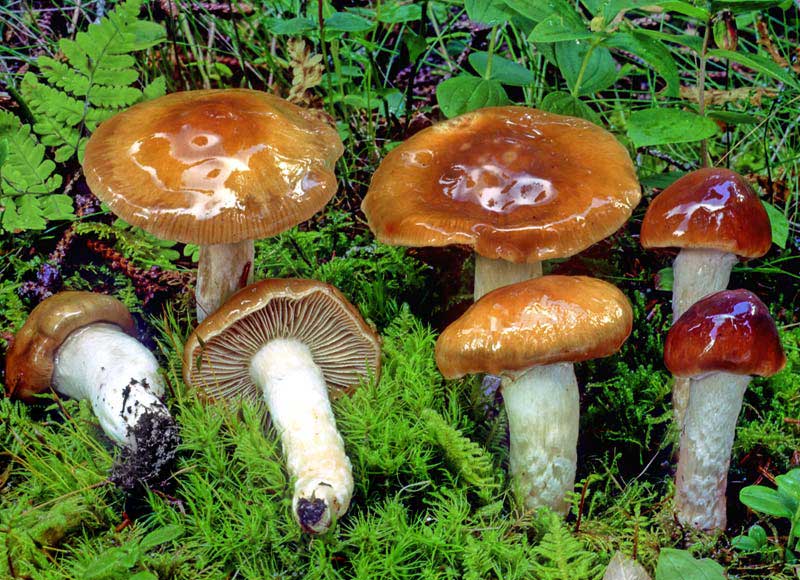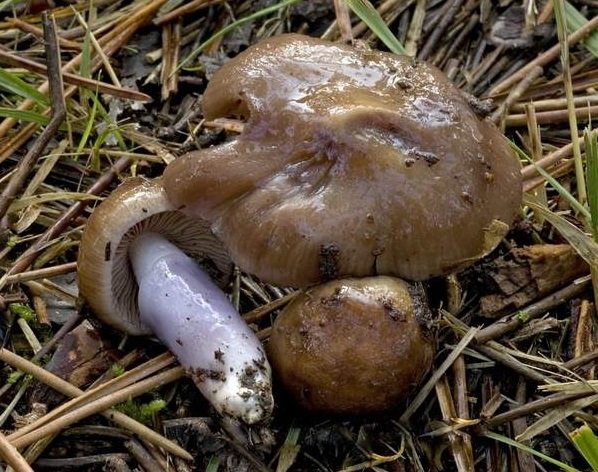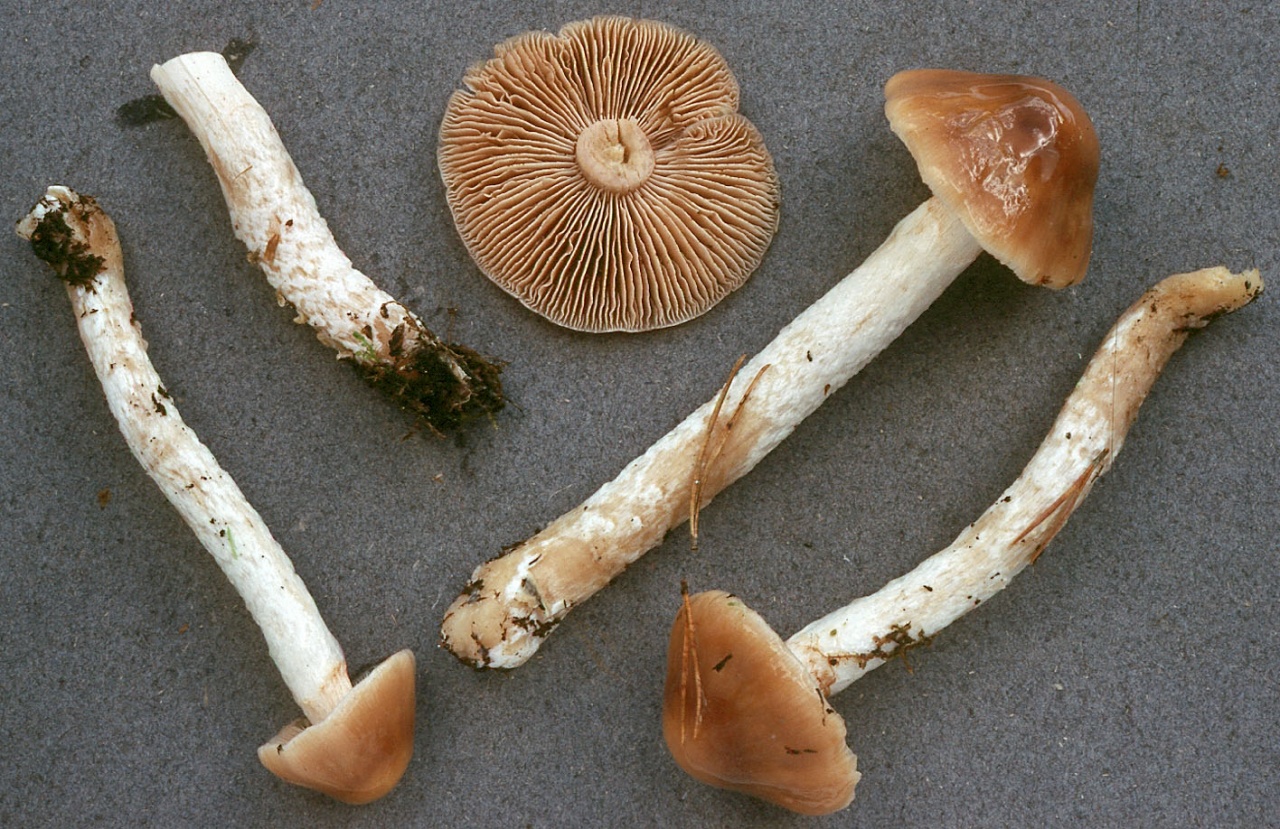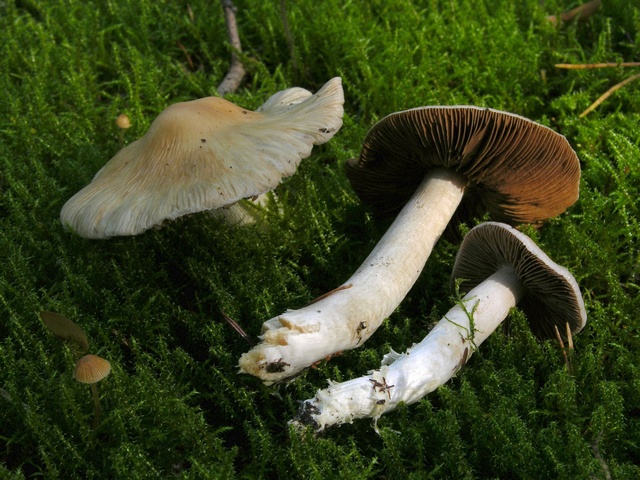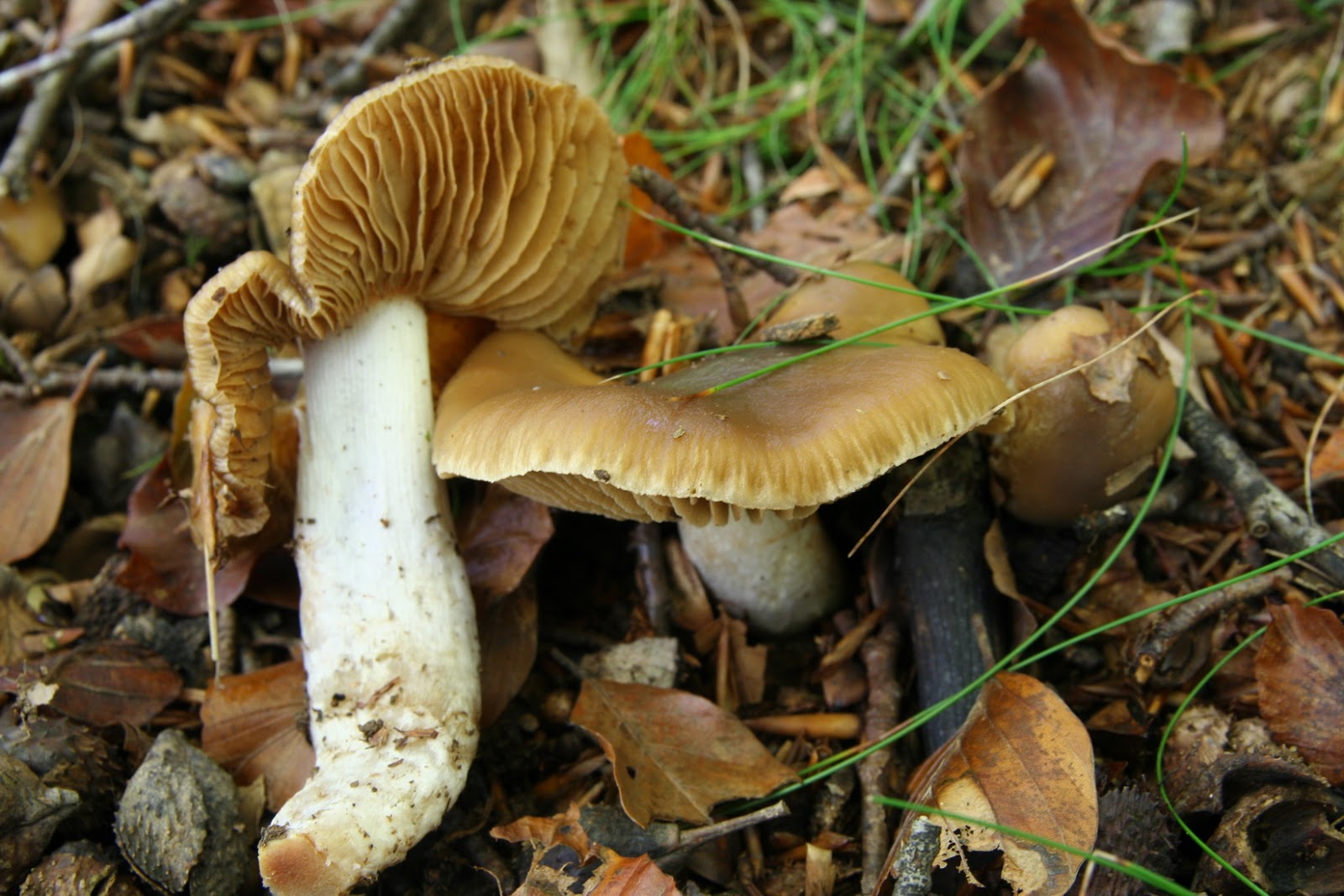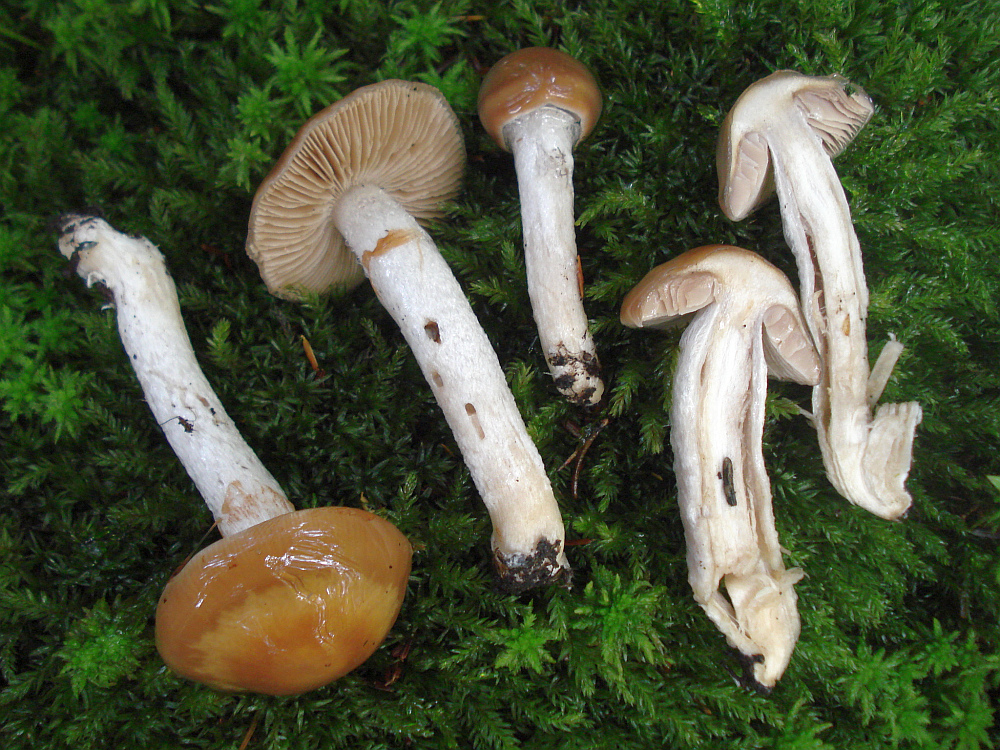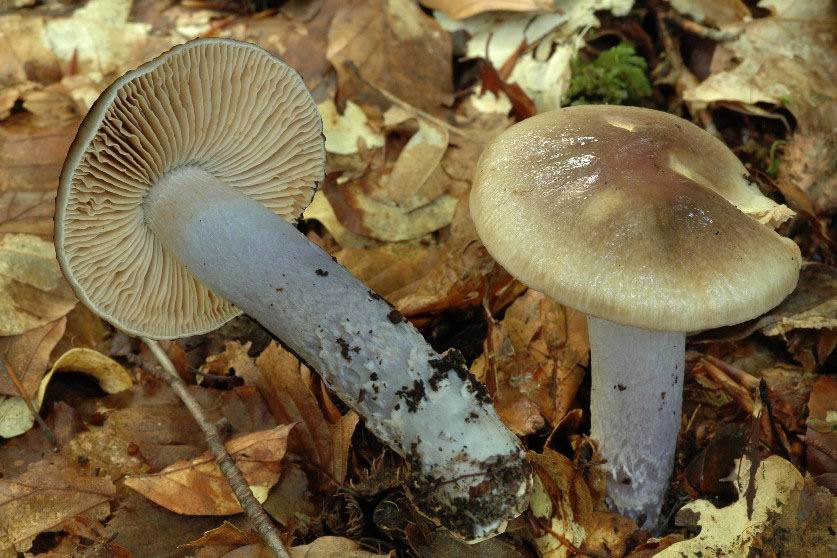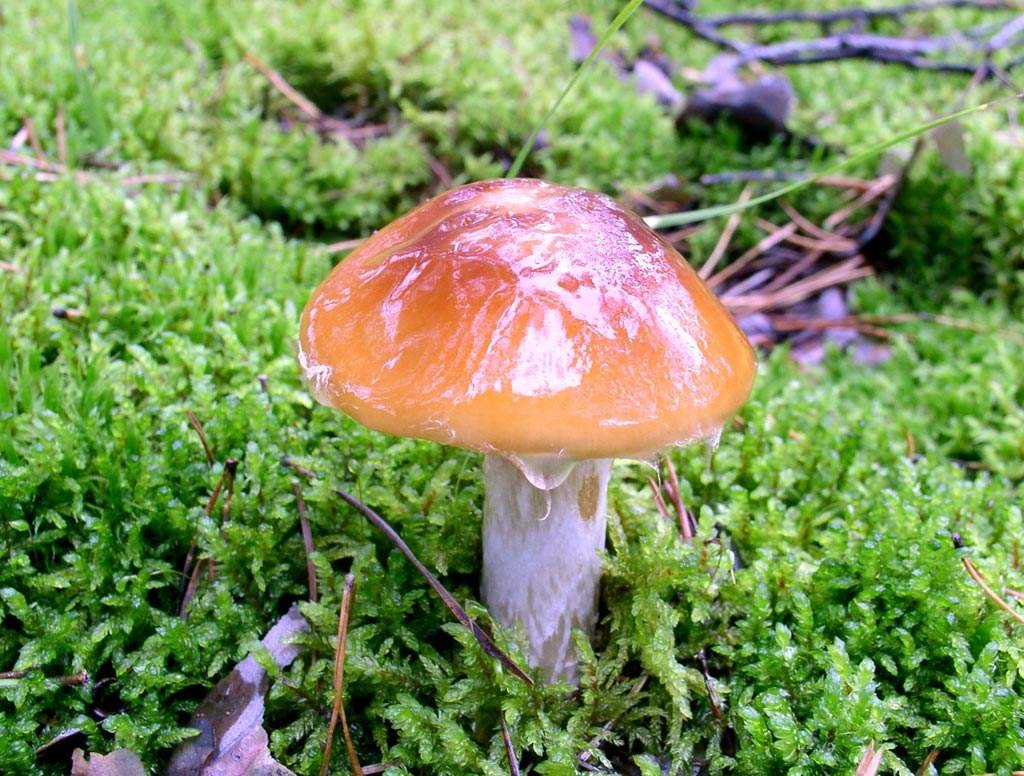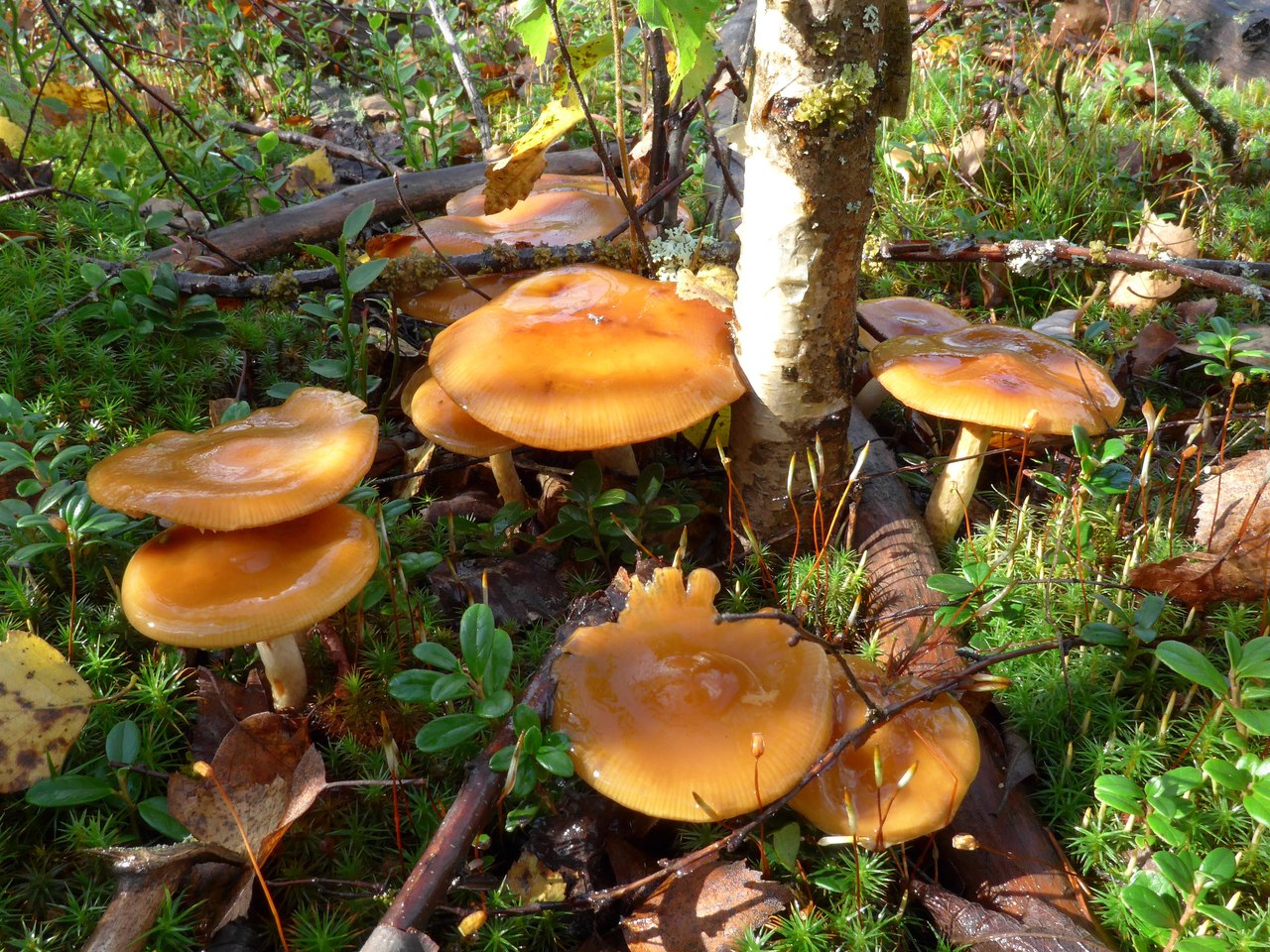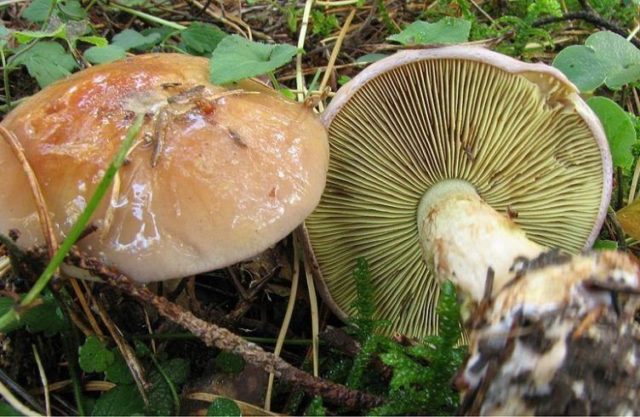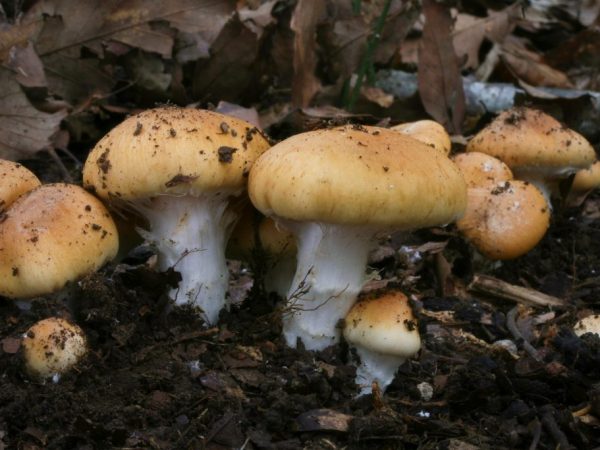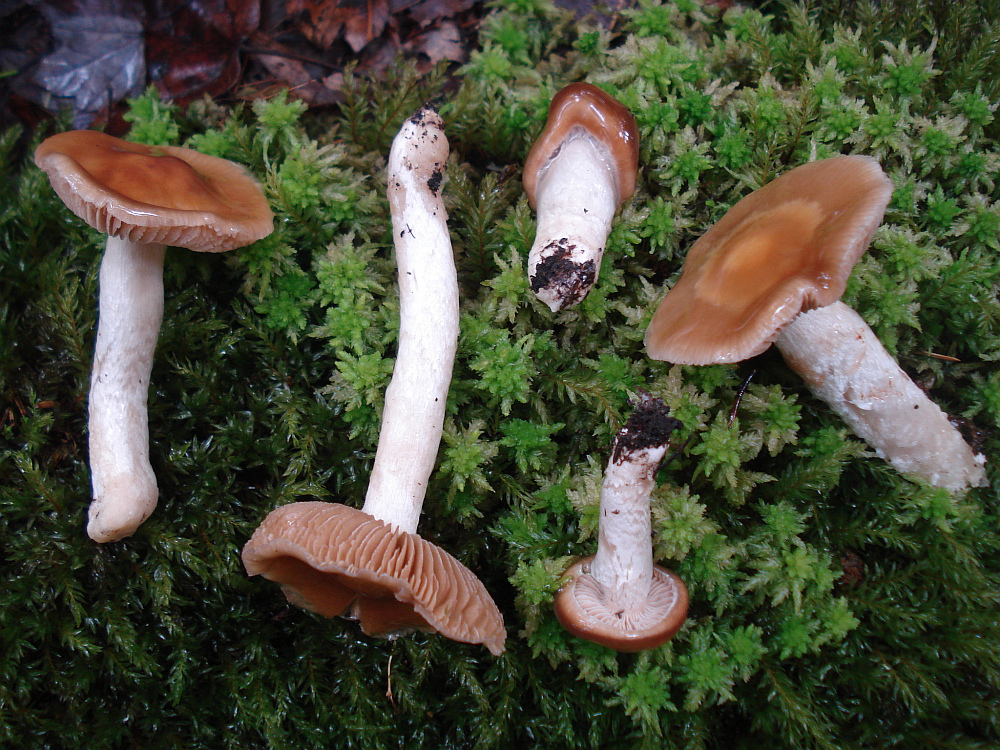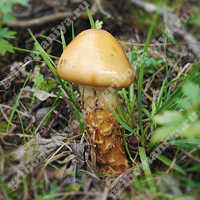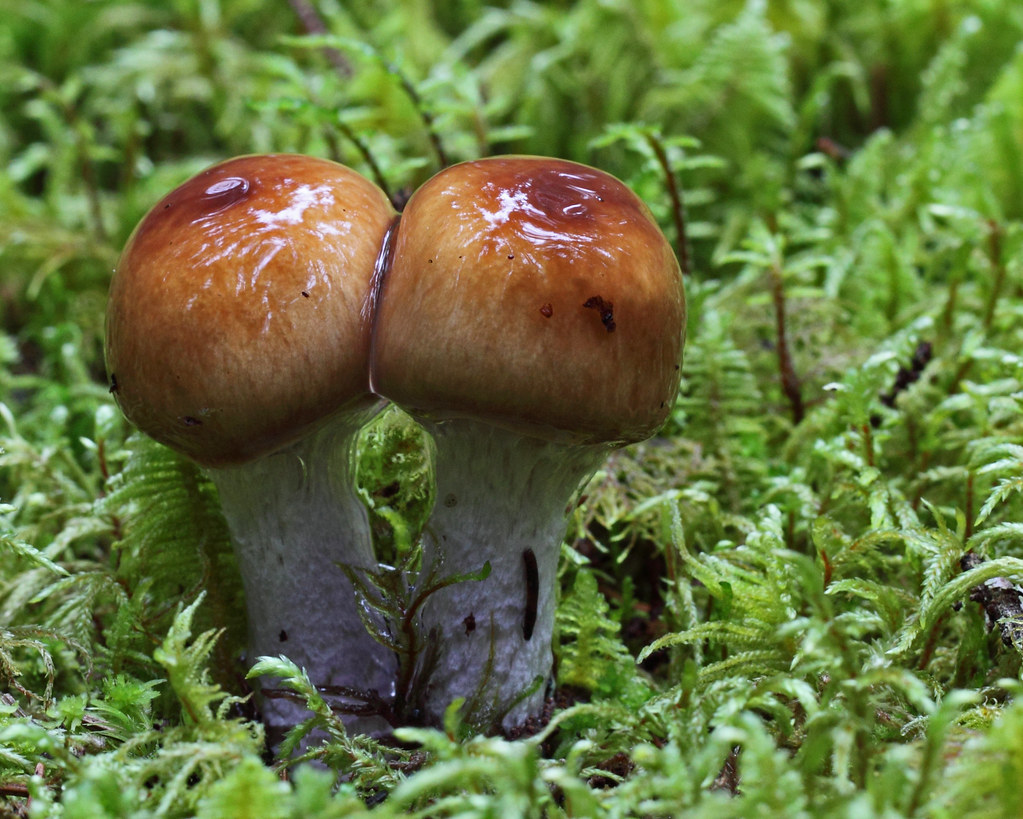Description of the mushroom
The common webcap, called in Latin Cortinarius trivialis, belongs to the family of Webcaps (or Cortinaria) and the genus Webcaps (agaric order). It is popularly known as Pribolotnik, as it grows mainly in wet areas. It acquired its name thanks to a kind of cobweb blanket, reminiscent of a veil-like film, which connects the edges of the cap with the leg. And the epithet "ordinary" symbolizes the classic, usual structure of the fruiting body and inexpressive color.
The cap of the mushroom reaches a diameter of 3 to 8 cm. In immature representatives of the species, it has a hemispherical, rounded-bell-shaped shape with curved edges. As the fungus grows, it becomes convex-outstretched with a wide, low tubercle in the center. At the same time, a small amount of mucus can be seen on the surface of the cap. The color varies from pale yellow or pale ocher with an olive tint to clay, honey brown and yellow brown. There are also fruiting bodies with a red-brown cap in the center and light edges.
The hymenophore (the lower part of the cap, on the surface of which there is a thin spore-bearing layer) is distinguished by wide, often located to each other, plates that grow together in the form of a tooth. In young mushrooms, this part has a yellow or whitish color, and in more mature ones, it is rusty brown or pale ocher. Also on the hymenophore, a barely noticeable cobweb cover of a whitish color with a mucous consistency is visible. The spore powder in the common spider web is yellowish-brown.
On the cut, the flesh of the mushroom is quite dense, ocher color (sometimes it acquires a light whitish tint), and closer to the base of the leg it becomes slightly brownish. The smell of the fruiting body is unpleasant, and the taste is inexpressive.
The leg of the common spider web is silky and dense. It has a cylindrical shape that tapers or sometimes widens towards the base. Its height is 5-10 cm, and its diameter is no more than 1-2 cm. In young representatives of the species, it is initially solid, and later becomes complete. The color of the leg is white, sometimes with a purple tint, brownish in the base area. The girdle on the stem resembles concentric fibers of yellow-brown and brown shades.
Cinnamon webcap
The webcap is dark brown;
Cinnamon spiderweb (Cortinarius cinnamomeus) is a type of mushroom belonging to the Spiderweb family, the Spiderweb genus. This mushroom is also called brown spider web, or dark brown spider web.
The brown webcap is also called the species Cortinarius brunneus (dark brown webcap), which is not related to this.
External description
The cinnamon webcap has a cap with a diameter of 2-4 cm, characterized by a hemispherical convex shape. Over time, the cap becomes open. In its central part there is a noticeable obtuse tubercle. The surface of the cap is dry to the touch, fibrous in structure, yellowish brownish brown or yellowish olive brown in color.
The mushroom stem is characterized by a cylindrical shape, initially well filled on the inside, but gradually becomes hollow. In girth, it is 0.3-0.6 cm, and in length it can vary from 2 to 8 cm. The color of the leg is yellowish-brown, lightening towards the base. The pulp of the mushroom has a yellow tint, sometimes turning into olive, it does not have a strong smell and taste.
The fungal hymenophore is represented by the lamellar type, consists of adherent yellow plates, gradually becoming brownish-yellow. In color, the plates are similar to a mushroom cap. They are thin in structure, often located.
Season and habitat
The cinnamon spider web begins to bear fruit in late summer and continues to harvest throughout September. Grows in deciduous and coniferous forests, widespread in the boreal zones of North America and Eurasia. Occurs in groups and singly.
Edibility
The nutritional properties of this type of mushroom are not fully understood.The unpleasant taste of the cinnamon spiderweb pulp makes it unfit for human consumption. This mushroom has several related species, which differ in their poisonousness. However, no poisonous substances were found in the cinnamon spider web; it is absolutely safe for human health.
Similar types and differences from them
One of the types of mushrooms similar to the cinnamon spider web is the saffron spider web. Their main difference from each other is the color of the hymenophore plates in young fruit chalk. In cinnamon cobweb, the plates have rich orange hues, and in saffron, the color of the plates tends to be more yellow. Sometimes there is confusion with the name of the cinnamon spider web. This term is often called a dark-brown spider web (Cortinarius brunneus), which is not even one of the species related to the described spider web.
An interesting fact is that the cinnamon spider web has the properties of dyeing materials. For example, with the help of its juice, you can easily dye wool in a rich burgundy red.
Webcap purple
The purple webcap (Latin name - Cortinarius Violaceus) is an edible mushroom of extraordinary beauty. Quite often it can be found in deciduous and coniferous forests. This plant is listed in the Red Book of the Russian Federation, as it is a very rare species of mushrooms.
The webcap belongs to the Lepista genus, to the Buttercup family. The following characteristic will present all the features of this plant.
Edible: conditionally edible.
Description
The purple spider web, or sometimes it is called the purple spiderweb, is the adornment of any forest. Despite the fact that it is conditionally edible, it is not recommended to collect it due to its uniqueness. During the mushroom season, it can be found only once. Its number decreases every year.
The mushroom cap can be up to 15 cm in diameter. It can be hemispherical or flat. There is a tubercle in the center. A young mushroom has a purple cap. In rare cases, its color may be red. It can fade over time. In the lower part there are wide plates.
The pulp at the break has a blue tint, and the smell of the mushroom is almost not felt. The pulp is quite fragile, it is easy to break it in your hands.
The stem of the mushroom is long and pleasant to the touch. The same can be said about armor. A thickening can be seen towards the base. During maturation, the stem can become tubular. The outer layer of the fungus is purple in color.
Where do they grow?
Very often, a purple cobweb can be found in damp birch forests. It can appear under spruce and pine trees. The most popular are single specimens, but groups of cobwebs are also rare.
Types of cobwebs
There are many varieties of cobwebs. The following are the most common ones:
• White and purple spider web. This mushroom cap belongs to the lamellar group. Its cap can reach 12 cm in diameter, and its edges are connected to the stem with a cobweb blanket. The flesh of the mushroom can be brown or light brown. It tastes and smells good.
• Scaly webcap. Its cap can be about 10 cm in diameter, it is convex or flat. In wet weather, it is slimy and shiny.
• The webcap is yellow. The most common representative of cobwebs, sometimes it is called yellow or triumphant spiderweb.
Beneficial features
The webcap contains many vitamins. It is composed of B1 and B2, zinc, copper, manganese. This mushroom is characterized by stearic acid and ergosterol. The medicinal properties of this plant are noted by many pharmacists. Such a conditionally edible mushroom is used in the manufacture of remedies for fungus, antibiotics. It is able to lower glucose levels. It can also be used to create drugs that control hypoglycemia. The cobweb has anti-inflammatory properties, it perfectly supports the activity of the immune system. Due to the large amount of vitamins, it helps to normalize the digestive tract, it also protects the body from infections and prevents overwork, fatigue.
Contraindications
If you take into account how much benefit this mushroom has in itself, you can understand that the contraindications here are insignificant.Some edible mushrooms can be confused with inedible mushrooms. The threat is posed by cobwebs that were collected near the road. They managed to absorb all the toxic substances. Such mushrooms are contraindicated for people with gastrointestinal diseases.
How to make a purple spider web salting?
To salt such a mushroom, it must be thoroughly washed and cleaned of contaminated areas. Then they are boiled in salted water. The water needs to be drained and then you can proceed to pickling the mushrooms.
You need to marinate them with vinegar, sunflower oil, salt and pepper. The mushrooms need to be immersed in a saucepan, add the listed ingredients and put on low heat. Spiderweb mushrooms will secrete a liquid in which salting occurs. Then they can be laid out in banks and stored for no more than 12 months in a cool place.
White-purple spider web, Cortinarius alboviolaceus
Hat: Medium size (diameter 5-8 cm), fleshy, bell-shaped or hemispherical in youth, as the mushroom matures, it acquires a characteristic half-extended shape with a blunt tubercle in the center. Color - light gray or silvery with a purple tint; the surface is not slimy, smooth, silky, covered with rather rare radial fibers of a more violet color in comparison with the base. The pulp is thick, grayish, friable, with an unpleasant musty smell characteristic of many cobwebs.
Hymenophore: The plates are poorly adherent, of medium frequency, narrow, with frequent veins; in adult mushrooms, they are rusty-brown; in young ones, while covered with a light gray cortina, they are gray-gray, bluish, but already with rusty edges.
Spore powder: Rusty brown.
Leg: Long and powerful (height 6-10 cm, thickness 1.5-2 cm), cylindrical, evenly expanding to the bottom, cap color, often with blue stains. The remnants of the silvery cortina are usually not visible, but when ripening spores fall on it, it becomes rusty-brown in color and becomes very noticeable. The flesh of the leg is gray-bluish, unevenly colored, often watery and friable.
Spreading: The white-purple webcap is found in September-October in deciduous and mixed forests, forming a mycorrhiza with a variety of trees. Prefers moist places, mosses, where it can appear in large quantities.
Similar species: There are many similar mushrooms among the endless genus of spider webs. From more violet varieties such as Cortinarius traganus, the white and purple cobweb is easily distinguished by the color of the cap, which is never so blue; Unlike C. salor, our figurant's leg and cap are not particularly slimy, except maybe rain. How to distinguish Cortinarus alboviolaceus from the silvery spider web, Cortinarius argentatus, does not exist in the popular literature; obviously, one should rely on the presence or absence of blue tones in the color. In general, the distinction of cobwebs, even such noticeable as white and purple, is extremely unpromising.
Edibility: According to literature data, it is not poisonous; according to the same data, it does not bring gastronomic joy to anyone.
Author's notes: The reportable Cortinarius alboviolaceus is another cobweb that can be identified right in the forest with at least some nonzero probability. That's why we love him. If it is, of course, he.
The tubercle is not visible, but it is. The white-purple cobweb is somewhat smaller than most similar blue or purple cobwebs, but in texture this mushroom is not much different from them - the same powerful and lumpy-headed. Under the silvery layer on the cap and stem, the latent blue is clearly visible, which gives a good reason to record this specimen in Cortinarius alboviolaceus.
The plates are brown, and the stripes on the leg are rusty. The rusty stripes on the leg of this white and purple spider web are the remains of a cortina, strewn with spores of the corresponding color. Why are cobwebs good - you don't even need to make an eruption of spore powder, everything is in full view. However, this feature does not help in the definition. Such are the mushrooms - cobwebs. Woven, excuse the expression, of riddles and contradictions.
Taxonomy, characteristics and description of the structure
The most beautiful cobweb (Latin name Cortinarius rubellus) is a lamellar mushroom representing the genus Cobweb, the Cobweb family, the Agaricomycete class. Another name is reddish cobweb.
The size of the cap in adult specimens varies from 3 to 8 cm in diameter. Its shape at a young age is conical, then it becomes flat or completely convex, in the center there is a small obtuse tubercle. The surface is velvety, dry, sometimes scaly to the edges, the color is from purple-brown to red and brown. The lower part of the cap (hymenophore) consists of rare, thick plates adhered to it, carrot-brown in color in young mushrooms and rusty-brown in mature ones.
The pulp is yellow-orange, has no taste, the smell is weak and rare, sometimes absent.
The leg is 5 to 12 cm long and 0.5 to 1.5 cm thick, has a cylindrical shape, slightly thickens downward. Its surface is fibrous, orange-brown in color, with remnants of a bedspread in the form of belts.
What does a poisonous spiderweb mushroom look like (with photo)
The name spiderweb means a genus of mushrooms of the family of the same name. Among mushroom pickers, the popular name pribolotnik is quite common, which reflects the peculiarities of the growth of the fungus. The mushroom got its main name due to the fact that at the junction of the leg and the cap it has a kind of cobweb, which practically disappears as it grows.
We offer you to familiarize yourself with Imeretian saffron: composition, calorie content, the benefits of marigolds, recipes
Interestingly, in appearance, different types of spider webs differ quite strongly, and novice mushroom pickers can take them for completely different families. There are fruit bodies of both classical shape and mushrooms with spherical and conical caps. The surface can be either dry or slimy, with a smooth or scaly texture. The color of the hats is also quite varied: yellow, orange, brown-red, burgundy and even white-violet.
Cobwebs grow alone, but more often in families from 10 to 30 pieces. They should be looked for in the lowlands, and they are collected mainly at the end of summer and until the onset of the first autumn frosts (late October in the European part of the country and the second half of September in Siberia).
Cobweb lazy Cobweb lazy
Goat webcap Common webcap
Lazy webcap (Cortinarius bolaris)
Lazy webcap in the photo
The mushroom is inedible. Caps up to 3-8 cm, at first hemispherical, then convex and finally open, clay-yellow, densely covered with large red or red-orange scales. In young mushrooms, the scales are glued to the surface of the cap; the yellow color of the surface is visible only as small gaps between the red scales.
In mature mushrooms, the scales diverge along the surface of the cap and lag behind it at the edge. The plates are clay-yellow, then brown, turn red when damaged. Leg 5-7 cm long, 5-15 mm thick, cylindrical, reddish-fibrous, often scaly, like a cap. The pulp is whitish with a brownish tinge. Spore powder yellow-green.
Grows in deciduous, mixed and coniferous forests on acidic soil.
Fruiting from August to September.
Goat webcap (Cortinarius traganus)
The goat webcap grows very abundantly in deciduous and coniferous forests
Goat webcap in the photo
The mushroom is inedible. Massive caps 3–12 cm, at first, spherical and lilac, then hemispherical and, finally, open ocher, with a fringed edge. The plates are buffy-yellow with a violet tinge, later brownish-ocher. The leg is lilac or yellow, with scales, 5-10 cm long, 2-3 cm wide, with an extension at the bottom. The pulp of young mushrooms is white-blue, then ocher with an unpleasant "goat" smell of acetylene.
We suggest that you familiarize yourself with Cornelian cherry and barberry: the same or not, what is the difference, description of crops
The goat spider web has no poisonous counterparts.
Common webcap (Cortinarius triviah)
Common webcap in the photo
The edibility of the mushroom is questionable. Caps up to 5-8 cm, at first hemispherical, then convex or open, mucous yellow-rusty-brown, dry straw-yellow Plates are white-gray with a violet tinge, later rusty brown. Leg yellow or bluish, 8-12 cm long, 1-2 cm wide, covered with mucus in the upper part, with dark belts in the lower part. The pulp is light, whitish-buffy, in old mushrooms with a weak unpleasant odor.
It looks like an inedible slimy spider web (Cortinarius mucosus) with a white leg.
Spider web brilliant: photo and description
| Name: | The webcap is brilliant |
| Latin name: | Cortinarius evernius |
| Type of: | Inedible |
| Specifications: |
|
| Systematics: |
|
The brilliant webcap (Cortinarius evernius) belongs to the Cobweb family and is extremely rare in Russia. During wet weather, its cap becomes shiny and becomes covered with transparent mucus, acquiring a glossy sheen, which is why it got its name.
What a brilliant spider web looks like
In accordance with its generic name, the mushroom has the remains of a velum with a spider-like structure. The flesh is tasteless, reddish in color with a slight unpleasant odor.
The spore body of the spider web is of a brilliant brown hue, consists of rare plates adhered to the leg. The spore powder has a rusty brown color. The spores themselves are medium-sized, smooth-walled, oval in shape.
In a young mushroom, the shape is at first sharp-bellied, dark brown in color with a lilac tint
Description of the hat
The cap of the mushroom is round in shape, its diameter is about 3-4 cm. With age, it opens, the fields increase, a small tubercle remains in the center. The color ranges from dark brown with a lilac tint to rusty orange.
The plates on the inner side, adhered with a tooth, are wide, have a medium frequency. The color is grayish-brown, later they acquire a chestnut color with a purple tint. The cobweb blanket remains white throughout the growth.
The flesh of the cap is also thin, but dense, has a brown color with a lilac tint
Leg description
The stem of the mushroom is in the shape of a cylinder, tapering towards the base. It is 5-10 cm long and about 0.5-1 cm in diameter. The color varies from gray to purple-coffee. White rings are noticeable along the entire length, which disappear with increased humidity.
Inside the leg is hollow, smooth and fibrous-silky
Where and how it grows
The most common cobweb is brilliant in the north of the European part of Russia and in the middle zone, it is also found in the Caucasus. The season starts at the end of summer - from the second half of August. Grows in mixed and coniferous forests.
Most often found in mossy places with high humidity: ravines, lowlands or near swamps. Glittering cobwebs grow in small groups of 2-4 mushrooms at the foot of pines and firs. Also found singly under bushes and among fallen leaves
Is the mushroom edible or not
The brilliant webcap belongs to inedible mushrooms. It does not contain any toxic substances and is not hazardous to health, but the unpleasant smell and taste of the pulp make it unsuitable for human consumption.
Doubles and their differences
The brilliant webcap can be easily confused with several more representatives of this species.
Slime cobweb (Cortinarius mucifluus) - is a conditionally edible species. The diameter of the cap is from 10 to 12 cm. The shape is bell-shaped at first, then straightens and becomes flat with uneven jagged edges. The leg is fusiform, 15-20 cm long, with a white color. The pulp is creamy, tasteless and odorless.
It differs from the brilliant cobweb in the absence of an unpleasant odor and mucus on the cap, even in dry weather
The most beautiful or reddish webcap (Cortinarius rubellus) is a poisonous mushroom that belongs to inedible. The length of the leg is 5-12 cm and from 0.5 to 1.5 cm in thickness, it expands downward.It has a brown-orange fibrous surface with light rings along its entire length. The diameter of the cap varies from 4 to 8 cm. The initial shape is conical. Further, it levels out, leaving a small convex mound at the top. The surface is smooth and dry with irregular edges of a brownish-red or brownish-purple color. The pulp is yellow-orange in color, odorless and tasteless.
It differs from the spiderweb of a brilliant rusty-reddish color and a lighter shade of the cap
Conclusion
The brilliant webcap is strictly not recommended to be cut and eaten. Having found it in the forest, you should be extremely careful: other edible spiderwebs can be confused with it. Most often it can be found in forests with a predominance of pines and birches.
Common webcap (Cortinarius trivialis) what it looks like, where and how it grows, edible or not
Common webcap: photo and description
| Name: | Common webcap |
| Latin name: | Cortinarius trivialis |
| Type of: | Inedible |
| Specifications: |
|
| Systematics: |
|
The common webcap (lat.Cortinarius trivialis) is a small mushroom of the Cobweb family. The second name - Pribolotnik - he received for preference to growing conditions. It is found in wet, swampy areas.
A detailed description of the Common Webcap with photos and videos is presented below.
Description of the common webcap
The mushroom was called a cobweb for a kind of "veil" of a cobweb film that is present in young specimens. The rest of the appearance is unremarkable.
Description of the hat
Pribolotnik's cap is small: 3-8 cm in diameter. At the initial stage of development, it has the shape of a hemisphere, which is later revealed. The color of the cap ranges from pale yellow tones to ocher and light brown shades. The core is darker than the edges.
The cap is sticky to the touch, there is a small amount of mucus on it. The surface of the hymenophore is lamellar. In young fruit bodies, it is white, and in mature specimens it darkens to yellowish and brown tones.
The pulp is dense and fleshy, white, with a harsh odor.
Leg description
The leg is 6-10 cm in height, the diameter is 1.5-2 cm. Slightly narrowed towards the base. There are specimens with a reverse structure - there is a small expansion at the bottom. The color of the leg is white, closer to the ground it darkens to a brown tint. Above from the cobweb blanket are brown concentric fibrous bands. From the middle of the leg to the base - weakly expressed.
Where and how it grows
Podbolnik can be found under birches and aspens, rarely under alder. It rarely lives in coniferous forests. Grows singly or in small groups in damp places.
In Russia, the distribution area of the species falls on the middle climatic zone.
Fruiting from July to September.
Edible webcap common or not
The nutritional properties of the Common Webcap have not been studied, but it does not apply to edible mushrooms. This species cannot be eaten.
Related specimens contain dangerous toxins in the pulp.
Poisoning symptoms, first aid
The danger of toxic species of this family is that the first signs of poisoning appear gradually: up to 1-2 weeks after eating mushrooms. Symptoms look like this:
- intense thirst;
- nausea, vomiting;
- stomach ache;
- spasms in the lumbar region.
If you find the first signs of poisoning, you must urgently consult a doctor or call an ambulance. Before receiving qualified treatment, you need to:
- flush the stomach using activated charcoal;
- plentiful drink (3-5 tbsp. boiled water in small sips);
- take a laxative to cleanse the intestines.
Doubles and their differences
The podbolnik is confused with other members of the family, as they are quite similar. The greatest similarity is noted with the mucous webcap (lat.Cortinarius mucosus).
The hat is 5-10 cm in diameter. It has a thin edge and a thick center, abundantly covered with transparent mucus. The leg is slender, cylindrical, 6-12 cm long, 1-2 cm thick.
It differs from Pribolotnik in abundant mucus and the shape of a cap.
Grows in coniferous and mixed forests under pine trees. Bears fruit singly.
The slime webcap (lat.Cortinarius mucifluus) is another twin of the Pribolotnik, which is confused with the mucous webcap because of a similar name. The hat with a diameter of 10-12 cm is abundantly covered with mucus. The stem is 20 cm long in the form of a spindle, also covered with mucus. Prefers coniferous forests.
It differs from Pribolotnik in abundant mucus and a longer leg.
Conclusion
The common webcap is an inedible mushroom, its properties have not been fully studied. Can be confused with other members of the family, the use of which is not recommended. The greatest similarity is noted with the Slime Webcap and the Slime Webcap, but they can be distinguished by their cap. In the latter, it is abundantly covered with mucus.
Additional information about the common webcap:
Classification and representatives
Main article: Taxa of the genus Spiderweb
On the basis of macroscopic, microscopic and chemical characters, the genus is divided into 4-7 taxa, which were previously considered as subgenera or sections; in new systems, subgenera are divided into a large number of sections.
In 1821 E. Fries divided the genus into 6 subgenera: Myxacium, Phlegmacium, Inoloma (= Cortinarius sensu stricto), Dermocybe, Telamonia and Hydrocybe... Moser in 1955, taking the Fries system as a basis, identified 5 independent genera, but he (together with Singer) in 1962 again lowered their rank to subgenera, with changes in their composition.This classification is also adopted in new systems, but the assignment of species to subgenera can vary considerably among different authors.
Cortinarius - one of the largest genera of the Agarikov order. Different authors indicate a different number of species in the genus, usually up to 700, but according to the most complete edition - "Dictionary of mushrooms", the number of species exceeds 2000.
Subgenera (according to Nezdoyminy (1996), corresponds to the Moser - Singer system (1962)):
- Phlegmacium (Fr.) Fr.
- Sericeocybe P.D. Orton
- Myxacium (Fr.) Loud.
- Telamonia (Fr.) Loud.
- Leprocybe Mos.
- Cortinarius
- Dermocybe (Fr.) Sacc.
Some species:
| Cat. * | Latin name | Russian name | ||||||||||
|---|---|---|---|---|---|---|---|---|---|---|---|---|
| Cortinarius alboviolaceus | Webcap white-purple | |||||||||||
| Cortinarius balteatocumatilis | Webcap bluish belted | |||||||||||
| Cortinarius anomalus | The webcap is abnormal | |||||||||||
| Cortinarius anserinus | Goose webcap | |||||||||||
| Cortinarius armillatus | Bracelet webcap | |||||||||||
| Cortinarius auroturbinatus | Beautiful clubfoot webcap | |||||||||||
| Cortinarius bolaris | Lazy webcap, or red-scaly, or hulk webcap | |||||||||||
| Cortinarius camphoratus | Webcap camphor | |||||||||||
| Cortinarius cinnamomeus | Cinnamon webcap | |||||||||||
| Cortinarius collinitus | Blue-bore webcap | |||||||||||
| Cortinarius cotoneus | Wadded webcap | |||||||||||
| Cortinarius crassus | Thick-fleshy webcap | |||||||||||
| Cortinarius cumatilis | Spider web is watery blue, or gray-blue | |||||||||||
| Cortinarius elegantior | The webcap is elegant | |||||||||||
| Cortinarius elegantissimus | The most elegant webcap | |||||||||||
| Cortinarius evernius | The webcap is brilliant | |||||||||||
| Cortinarius herculeus | Webcap of Hercules | |||||||||||
| Cortinarius largus | The webcap is large, or abundant | |||||||||||
| Cortinarius limonius | Cobweb lion-yellow | |||||||||||
| Cortinarius mucosus | Slimy webcap | |||||||||||
| Cortinarius multiformis | Diverse webcap | |||||||||||
| Cortinarius odorifer | Anise webcap | |||||||||||
| Cortinarius orellanus | Mountain webcap, or plush, or orange-red, or poisonous | |||||||||||
| Cortinarius paleaceus | Filmy webcap | |||||||||||
| Cortinarius phoeniceus | Cobweb purple | |||||||||||
| Cortinarius pholideus | Scaly webcap | |||||||||||
| Cortinarius praestans | The webcap is excellent | |||||||||||
| Cortinarius purpurascens | The webcap is crimson, or reddish | |||||||||||
| Cortinarius rubellus | Reddish cobweb | |||||||||||
| Cortinarius rufoolivaceus | Red & olive spiderweb | |||||||||||
| Cortinarius sanguineis | Webcap blood red | |||||||||||
| Cortinarius semisanguineus | Webcap half-blood red | |||||||||||
| Cortinarius sodagnitis | The cobweb is recognizable | |||||||||||
| Cortinarius speciosissimus | The webcap is beautiful | |||||||||||
| Cortinarius splendens | The webcap is shiny | |||||||||||
| Cortinarius terpsichores | Webcap of Terpsichore | |||||||||||
| Cortinarius torvus | Gloomy webcap | |||||||||||
| Cortinarius traganus | Goat's webcap, or lilac thick-legged | |||||||||||
| Cortinarius triumphans | Triumphal webcap | |||||||||||
| Cortinarius trivialis | Common webcap | |||||||||||
| Cortinarius variecolor | Multi-colored webcap | |||||||||||
| Cortinarius varius | Changeable webcap, or brick-yellow | |||||||||||
| Cortinarius violaceus | Webcap purple | |||||||||||
|

